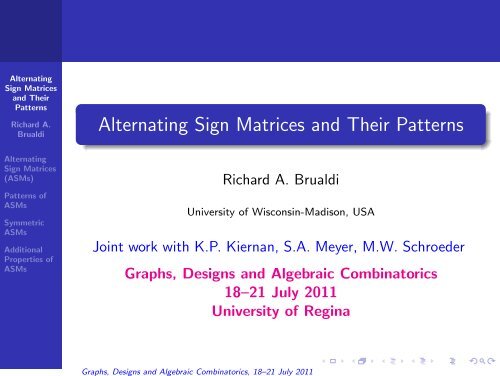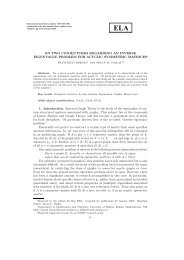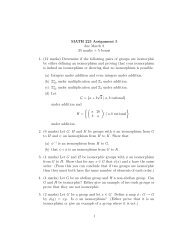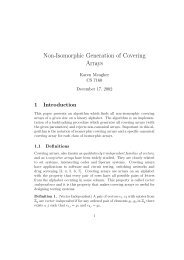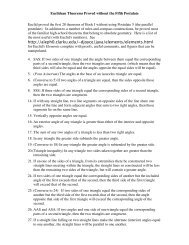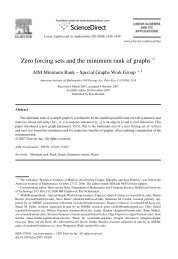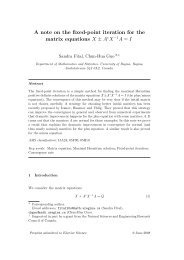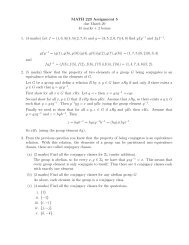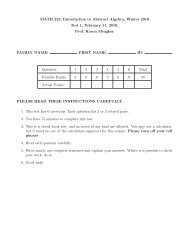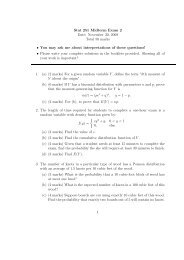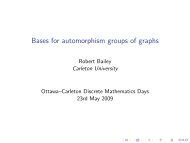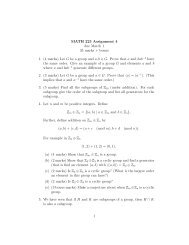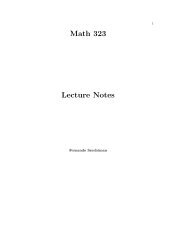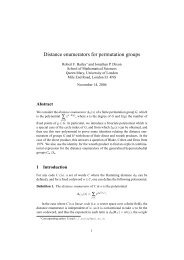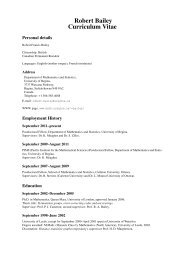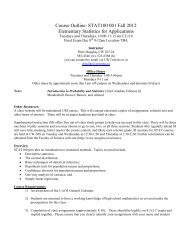Richard Brualdi - University of Regina
Richard Brualdi - University of Regina
Richard Brualdi - University of Regina
You also want an ePaper? Increase the reach of your titles
YUMPU automatically turns print PDFs into web optimized ePapers that Google loves.
Graphs, Designs and Algebraic Combinatorics, 18–21 July 2011<br />
Alternating<br />
Sign Matrices<br />
and Their<br />
Patterns<br />
<strong>Richard</strong> A.<br />
<strong>Brualdi</strong><br />
Alternating Sign Matrices and Their Patterns<br />
Alternating<br />
Sign Matrices<br />
(ASMs)<br />
Patterns <strong>of</strong><br />
ASMs<br />
Symmetric<br />
ASMs<br />
Additional<br />
Properties <strong>of</strong><br />
ASMs<br />
<strong>Richard</strong> A. <strong>Brualdi</strong><br />
<strong>University</strong> <strong>of</strong> Wisconsin-Madison, USA<br />
Joint work with K.P. Kiernan, S.A. Meyer, M.W. Schroeder<br />
Graphs, Designs and Algebraic Combinatorics<br />
18–21 July 2011<br />
<strong>University</strong> <strong>of</strong> <strong>Regina</strong>
Graphs, Designs and Algebraic Combinatorics, 18–21 July 2011<br />
Alternating<br />
Sign Matrices<br />
and Their<br />
Patterns<br />
<strong>Richard</strong> A.<br />
<strong>Brualdi</strong><br />
1 Alternating Sign Matrices (ASMs)<br />
Alternating<br />
Sign Matrices<br />
(ASMs)<br />
Patterns <strong>of</strong><br />
ASMs<br />
Symmetric<br />
ASMs<br />
Additional<br />
Properties <strong>of</strong><br />
ASMs<br />
2 Patterns <strong>of</strong> ASMs<br />
3 Symmetric ASMs<br />
4 Additional Properties <strong>of</strong> ASMs
Graphs, Designs and Algebraic Combinatorics, 18–21 July 2011<br />
What is an ASM?<br />
Alternating<br />
Sign Matrices<br />
and Their<br />
Patterns<br />
<strong>Richard</strong> A.<br />
<strong>Brualdi</strong><br />
Alternating<br />
Sign Matrices<br />
(ASMs)<br />
Patterns <strong>of</strong><br />
ASMs<br />
Symmetric<br />
ASMs<br />
Additional<br />
Properties <strong>of</strong><br />
ASMs<br />
n × n (0, 1, −1)-matrix such that in each row and column the<br />
1s and −1s alternate beginning and ending with 1.<br />
Examples:<br />
Permutation matrices.<br />
⎡<br />
⎤ ⎡<br />
⎤<br />
0 1 0 0 + 0<br />
⎣ 1 −1 1 ⎦ −→ ⎣ + − + ⎦.<br />
0 1 0 0 + 0<br />
⎡<br />
⎤<br />
0 0 + 0 0<br />
0 + − + 0<br />
⎢ + − + − +<br />
⎥<br />
⎣ 0 + − + 0 ⎦<br />
0 0 + 0 0
Graphs, Designs and Algebraic Combinatorics, 18–21 July 2011<br />
What is an ASM?<br />
Alternating<br />
Sign Matrices<br />
and Their<br />
Patterns<br />
<strong>Richard</strong> A.<br />
<strong>Brualdi</strong><br />
Alternating<br />
Sign Matrices<br />
(ASMs)<br />
Patterns <strong>of</strong><br />
ASMs<br />
Symmetric<br />
ASMs<br />
Additional<br />
Properties <strong>of</strong><br />
ASMs<br />
n × n (0, 1, −1)-matrix such that in each row and column the<br />
1s and −1s alternate beginning and ending with 1.<br />
Examples:<br />
Permutation matrices.<br />
⎡<br />
⎤ ⎡<br />
⎤<br />
0 1 0 0 + 0<br />
⎣ 1 −1 1 ⎦ −→ ⎣ + − + ⎦.<br />
0 1 0 0 + 0<br />
⎡<br />
⎤<br />
0 0 + 0 0<br />
0 + − + 0<br />
⎢ + − + − +<br />
⎥<br />
⎣ 0 + − + 0 ⎦<br />
0 0 + 0 0
Graphs, Designs and Algebraic Combinatorics, 18–21 July 2011<br />
What is an ASM?<br />
Alternating<br />
Sign Matrices<br />
and Their<br />
Patterns<br />
<strong>Richard</strong> A.<br />
<strong>Brualdi</strong><br />
Alternating<br />
Sign Matrices<br />
(ASMs)<br />
Patterns <strong>of</strong><br />
ASMs<br />
Symmetric<br />
ASMs<br />
Additional<br />
Properties <strong>of</strong><br />
ASMs<br />
n × n (0, 1, −1)-matrix such that in each row and column the<br />
1s and −1s alternate beginning and ending with 1.<br />
Examples:<br />
Permutation matrices.<br />
⎡<br />
⎤ ⎡<br />
⎤<br />
0 1 0 0 + 0<br />
⎣ 1 −1 1 ⎦ −→ ⎣ + − + ⎦.<br />
0 1 0 0 + 0<br />
⎡<br />
⎤<br />
0 0 + 0 0<br />
0 + − + 0<br />
⎢ + − + − +<br />
⎥<br />
⎣ 0 + − + 0 ⎦<br />
0 0 + 0 0
Graphs, Designs and Algebraic Combinatorics, 18–21 July 2011<br />
What is an ASM?<br />
Alternating<br />
Sign Matrices<br />
and Their<br />
Patterns<br />
<strong>Richard</strong> A.<br />
<strong>Brualdi</strong><br />
Alternating<br />
Sign Matrices<br />
(ASMs)<br />
Patterns <strong>of</strong><br />
ASMs<br />
Symmetric<br />
ASMs<br />
Additional<br />
Properties <strong>of</strong><br />
ASMs<br />
n × n (0, 1, −1)-matrix such that in each row and column the<br />
1s and −1s alternate beginning and ending with 1.<br />
Examples:<br />
Permutation matrices.<br />
⎡<br />
⎤ ⎡<br />
⎤<br />
0 1 0 0 + 0<br />
⎣ 1 −1 1 ⎦ −→ ⎣ + − + ⎦.<br />
0 1 0 0 + 0<br />
⎡<br />
⎤<br />
0 0 + 0 0<br />
0 + − + 0<br />
⎢ + − + − +<br />
⎥<br />
⎣ 0 + − + 0 ⎦<br />
0 0 + 0 0
Graphs, Designs and Algebraic Combinatorics, 18–21 July 2011<br />
What is an ASM?<br />
Alternating<br />
Sign Matrices<br />
and Their<br />
Patterns<br />
<strong>Richard</strong> A.<br />
<strong>Brualdi</strong><br />
Alternating<br />
Sign Matrices<br />
(ASMs)<br />
Patterns <strong>of</strong><br />
ASMs<br />
Symmetric<br />
ASMs<br />
Additional<br />
Properties <strong>of</strong><br />
ASMs<br />
n × n (0, 1, −1)-matrix such that in each row and column the<br />
1s and −1s alternate beginning and ending with 1.<br />
Examples:<br />
Permutation matrices.<br />
⎡<br />
⎤ ⎡<br />
⎤<br />
0 1 0 0 + 0<br />
⎣ 1 −1 1 ⎦ −→ ⎣ + − + ⎦.<br />
0 1 0 0 + 0<br />
⎡<br />
⎤<br />
0 0 + 0 0<br />
0 + − + 0<br />
⎢ + − + − +<br />
⎥<br />
⎣ 0 + − + 0 ⎦<br />
0 0 + 0 0
Graphs, Designs and Algebraic Combinatorics, 18–21 July 2011<br />
Another Example <strong>of</strong> an ASM<br />
Alternating<br />
Sign Matrices<br />
and Their<br />
Patterns<br />
<strong>Richard</strong> A.<br />
<strong>Brualdi</strong><br />
Alternating<br />
Sign Matrices<br />
(ASMs)<br />
Patterns <strong>of</strong><br />
ASMs<br />
Symmetric<br />
ASMs<br />
Additional<br />
Properties <strong>of</strong><br />
ASMs<br />
⎡<br />
⎢<br />
⎣<br />
+<br />
+ − +<br />
+<br />
+ − +<br />
+ − + − +<br />
+<br />
+<br />
+<br />
⎤<br />
.<br />
⎥<br />
⎦
Basic Properties <strong>of</strong> ASMs<br />
Alternating<br />
Sign Matrices<br />
and Their<br />
Patterns<br />
<strong>Richard</strong> A.<br />
<strong>Brualdi</strong><br />
Alternating<br />
Sign Matrices<br />
(ASMs)<br />
Patterns <strong>of</strong><br />
ASMs<br />
Symmetric<br />
ASMs<br />
Additional<br />
Properties <strong>of</strong><br />
ASMs<br />
The first and last rows and columns in an ASM always<br />
contain exactly one + and no −.<br />
The number <strong>of</strong> nonzeros in each row and column is odd.<br />
all row and column sums equal 1.<br />
(number <strong>of</strong> +’s) = n + (number <strong>of</strong> −’s).<br />
The partial row (column) sums starting from the first or<br />
last entry in a row (column) equal 0 or 1.<br />
Invariant under the dihedral group <strong>of</strong> order 8 (symmetries<br />
<strong>of</strong> a square).<br />
⎡ ⎤<br />
+<br />
⎢ ⎢⎢⎢⎢⎢⎣<br />
+ − +<br />
+ − + − +<br />
+ − + − +<br />
⎥<br />
+ − + ⎦<br />
+<br />
Graphs, Designs and Algebraic Combinatorics, 18–21 July 2011
Basic Properties <strong>of</strong> ASMs<br />
Alternating<br />
Sign Matrices<br />
and Their<br />
Patterns<br />
<strong>Richard</strong> A.<br />
<strong>Brualdi</strong><br />
Alternating<br />
Sign Matrices<br />
(ASMs)<br />
Patterns <strong>of</strong><br />
ASMs<br />
Symmetric<br />
ASMs<br />
Additional<br />
Properties <strong>of</strong><br />
ASMs<br />
The first and last rows and columns in an ASM always<br />
contain exactly one + and no −.<br />
The number <strong>of</strong> nonzeros in each row and column is odd.<br />
all row and column sums equal 1.<br />
(number <strong>of</strong> +’s) = n + (number <strong>of</strong> −’s).<br />
The partial row (column) sums starting from the first or<br />
last entry in a row (column) equal 0 or 1.<br />
Invariant under the dihedral group <strong>of</strong> order 8 (symmetries<br />
<strong>of</strong> a square).<br />
⎡ ⎤<br />
+<br />
⎢ ⎢⎢⎢⎢⎢⎣<br />
+ − +<br />
+ − + − +<br />
+ − + − +<br />
⎥<br />
+ − + ⎦<br />
+<br />
Graphs, Designs and Algebraic Combinatorics, 18–21 July 2011
Graphs, Designs and Algebraic Combinatorics, 18–21 July 2011<br />
Enumeration <strong>of</strong> ASMs<br />
Alternating<br />
Sign Matrices<br />
and Their<br />
Patterns<br />
<strong>Richard</strong> A.<br />
<strong>Brualdi</strong><br />
Alternating<br />
Sign Matrices<br />
(ASMs)<br />
Patterns <strong>of</strong><br />
ASMs<br />
Symmetric<br />
ASMs<br />
Additional<br />
Properties <strong>of</strong><br />
ASMs<br />
For small n, the number <strong>of</strong> n × n ASMs is:<br />
1, 2, 7, 42, 429, 7436, . . . .<br />
Major Theorem: The number <strong>of</strong> n × n ASMs is<br />
1!4!7! · · · (3n − 2)!<br />
n!(n + 1)!(n + 2)! · · · (2n − 1)! .<br />
(Zeilberger 1996 and Kuperberg 1996; conj. <strong>of</strong> Mills,<br />
Robbins, Rumsey 1983).<br />
1-1 correspondence between ASMs and “square ice”<br />
configurations: a system <strong>of</strong> water (H 2 O) molecules frozen<br />
in a square lattice.
Graphs, Designs and Algebraic Combinatorics, 18–21 July 2011<br />
Enumeration <strong>of</strong> ASMs<br />
Alternating<br />
Sign Matrices<br />
and Their<br />
Patterns<br />
<strong>Richard</strong> A.<br />
<strong>Brualdi</strong><br />
Alternating<br />
Sign Matrices<br />
(ASMs)<br />
Patterns <strong>of</strong><br />
ASMs<br />
Symmetric<br />
ASMs<br />
Additional<br />
Properties <strong>of</strong><br />
ASMs<br />
For small n, the number <strong>of</strong> n × n ASMs is:<br />
1, 2, 7, 42, 429, 7436, . . . .<br />
Major Theorem: The number <strong>of</strong> n × n ASMs is<br />
1!4!7! · · · (3n − 2)!<br />
n!(n + 1)!(n + 2)! · · · (2n − 1)! .<br />
(Zeilberger 1996 and Kuperberg 1996; conj. <strong>of</strong> Mills,<br />
Robbins, Rumsey 1983).<br />
1-1 correspondence between ASMs and “square ice”<br />
configurations: a system <strong>of</strong> water (H 2 O) molecules frozen<br />
in a square lattice.
Graphs, Designs and Algebraic Combinatorics, 18–21 July 2011<br />
Enumeration <strong>of</strong> ASMs<br />
Alternating<br />
Sign Matrices<br />
and Their<br />
Patterns<br />
<strong>Richard</strong> A.<br />
<strong>Brualdi</strong><br />
Alternating<br />
Sign Matrices<br />
(ASMs)<br />
Patterns <strong>of</strong><br />
ASMs<br />
Symmetric<br />
ASMs<br />
Additional<br />
Properties <strong>of</strong><br />
ASMs<br />
For small n, the number <strong>of</strong> n × n ASMs is:<br />
1, 2, 7, 42, 429, 7436, . . . .<br />
Major Theorem: The number <strong>of</strong> n × n ASMs is<br />
1!4!7! · · · (3n − 2)!<br />
n!(n + 1)!(n + 2)! · · · (2n − 1)! .<br />
(Zeilberger 1996 and Kuperberg 1996; conj. <strong>of</strong> Mills,<br />
Robbins, Rumsey 1983).<br />
1-1 correspondence between ASMs and “square ice”<br />
configurations: a system <strong>of</strong> water (H 2 O) molecules frozen<br />
in a square lattice.
Square Ice I<br />
Alternating<br />
Sign Matrices<br />
and Their<br />
Patterns<br />
<strong>Richard</strong> A.<br />
<strong>Brualdi</strong><br />
Alternating<br />
Sign Matrices<br />
(ASMs)<br />
Patterns <strong>of</strong><br />
ASMs<br />
Symmetric<br />
ASMs<br />
Additional<br />
Properties <strong>of</strong><br />
ASMs<br />
There are oxygen atoms at each vertex <strong>of</strong> an n × n lattice, with<br />
hydrogen atoms between successive oxygen atoms in a row or<br />
column, and on either vertical side <strong>of</strong> the lattice, but not on<br />
the two horizontal sides. E.G. n = 4:<br />
H O H O H O H O H<br />
H H H H<br />
H O H O H O H O H<br />
H H H H<br />
H O H O H O H O H<br />
H H H H<br />
H O H O H O H O H<br />
.<br />
Each O is to be attached to two Hs to get a water molecule<br />
H 2 O, where no two oxygen atoms are attached to any <strong>of</strong> the<br />
same hydrogen atoms. There are six possible configurations in<br />
which an oxygen atom can be attached to two hydrogen atoms:<br />
Graphs, Designs and Algebraic Combinatorics, 18–21 July 2011
Graphs, Designs and Algebraic Combinatorics, 18–21 July 2011<br />
Square Ice II<br />
Alternating<br />
Sign Matrices<br />
and Their<br />
Patterns<br />
<strong>Richard</strong> A.<br />
<strong>Brualdi</strong><br />
Alternating<br />
Sign Matrices<br />
(ASMs)<br />
Patterns <strong>of</strong><br />
ASMs<br />
Symmetric<br />
ASMs<br />
Additional<br />
Properties <strong>of</strong><br />
ASMs<br />
H ← O → H<br />
H<br />
↑<br />
H ← O<br />
H<br />
↑<br />
O<br />
↓<br />
H<br />
H<br />
↑<br />
O → H<br />
O → H<br />
↓<br />
H<br />
H ← O<br />
↓<br />
H<br />
The top two configurations correspond to 1 and −1,<br />
respectively. The other four configurations correspond to 0.<br />
.
Square Ice III<br />
Alternating<br />
Sign Matrices<br />
and Their<br />
Patterns<br />
<strong>Richard</strong> A.<br />
<strong>Brualdi</strong><br />
Alternating<br />
Sign Matrices<br />
(ASMs)<br />
Patterns <strong>of</strong><br />
ASMs<br />
Symmetric<br />
ASMs<br />
Additional<br />
Properties <strong>of</strong><br />
ASMs<br />
(n = 4)<br />
H ← O H ← O H ← O → H O → H<br />
↓ ↓ ↓<br />
H H H H<br />
↑<br />
H ← O → H O → H O H ← O → H<br />
↓<br />
↓<br />
H H H H<br />
↑<br />
↑<br />
H ← O H ← O → H O → H O → H<br />
↓<br />
H H H H<br />
↑ ↑ ↑<br />
H ← O H ← O H ← O → H O → H<br />
and this corresponds to the ASM<br />
2<br />
6<br />
4<br />
Graphs, Designs and Algebraic Combinatorics, 18–21 July 2011<br />
0 0 1 0<br />
1 0 −1 1<br />
0 1 0 0<br />
0 0 1 0<br />
3<br />
7<br />
5 .
Graphs, Designs and Algebraic Combinatorics, 18–21 July 2011<br />
Patterns <strong>of</strong> n × n ASMs<br />
Alternating<br />
Sign Matrices<br />
and Their<br />
Patterns<br />
<strong>Richard</strong> A.<br />
<strong>Brualdi</strong><br />
Alternating<br />
Sign Matrices<br />
(ASMs)<br />
Patterns <strong>of</strong><br />
ASMs<br />
Symmetric<br />
ASMs<br />
Additional<br />
Properties <strong>of</strong><br />
ASMs<br />
An n × n ASM A has a decomposition <strong>of</strong> the form<br />
A = A 1 − A 2<br />
where A 1 and A 2 are (0, 1)-matrices (or (0, +)-matrices), e.g.,<br />
⎡<br />
⎤ ⎡<br />
⎤ ⎡<br />
⎤<br />
0 1 0 0 0 1 0 0 0 0 0 0<br />
⎢ 1 −1 1 0<br />
⎥<br />
⎣ 0 0 0 1 ⎦ = ⎢ 1 0 1 0<br />
⎥<br />
⎣ 0 0 0 1 ⎦ − ⎢ 0 1 0 0<br />
⎥<br />
⎣ 0 0 0 0 ⎦ .<br />
0 1 0 0 0 1 0 0 0 0 0 0<br />
The pattern <strong>of</strong> an ASM is the (0, 1)-matrix (or (0, +)-matrix)<br />
A 1 + A 2 . In the example, the pattern is<br />
⎡<br />
⎤ ⎡<br />
⎤ ⎡<br />
⎤<br />
0 1 0 0 0 + 0 0<br />
+<br />
⎢ 1 1 1 0<br />
⎥<br />
⎣ 0 0 0 1 ⎦ → ⎢ + + + 0<br />
⎥<br />
⎣ 0 0 0 + ⎦ → ⎢ + + +<br />
⎥<br />
⎣<br />
+ ⎦<br />
0 1 0 0 0 + 0 0<br />
+
Graphs, Designs and Algebraic Combinatorics, 18–21 July 2011<br />
Patterns <strong>of</strong> n × n ASMs<br />
Alternating<br />
Sign Matrices<br />
and Their<br />
Patterns<br />
<strong>Richard</strong> A.<br />
<strong>Brualdi</strong><br />
Alternating<br />
Sign Matrices<br />
(ASMs)<br />
Patterns <strong>of</strong><br />
ASMs<br />
Symmetric<br />
ASMs<br />
Additional<br />
Properties <strong>of</strong><br />
ASMs<br />
An n × n ASM A has a decomposition <strong>of</strong> the form<br />
A = A 1 − A 2<br />
where A 1 and A 2 are (0, 1)-matrices (or (0, +)-matrices), e.g.,<br />
⎡<br />
⎤ ⎡<br />
⎤ ⎡<br />
⎤<br />
0 1 0 0 0 1 0 0 0 0 0 0<br />
⎢ 1 −1 1 0<br />
⎥<br />
⎣ 0 0 0 1 ⎦ = ⎢ 1 0 1 0<br />
⎥<br />
⎣ 0 0 0 1 ⎦ − ⎢ 0 1 0 0<br />
⎥<br />
⎣ 0 0 0 0 ⎦ .<br />
0 1 0 0 0 1 0 0 0 0 0 0<br />
The pattern <strong>of</strong> an ASM is the (0, 1)-matrix (or (0, +)-matrix)<br />
A 1 + A 2 . In the example, the pattern is<br />
⎡<br />
⎤ ⎡<br />
⎤ ⎡<br />
⎤<br />
0 1 0 0 0 + 0 0<br />
+<br />
⎢ 1 1 1 0<br />
⎥<br />
⎣ 0 0 0 1 ⎦ → ⎢ + + + 0<br />
⎥<br />
⎣ 0 0 0 + ⎦ → ⎢ + + +<br />
⎥<br />
⎣<br />
+ ⎦<br />
0 1 0 0 0 + 0 0<br />
+
Graphs, Designs and Algebraic Combinatorics, 18–21 July 2011<br />
ASMs are ASBGs<br />
Alternating<br />
Sign Matrices<br />
and Their<br />
Patterns<br />
<strong>Richard</strong> A.<br />
<strong>Brualdi</strong><br />
Alternating<br />
Sign Matrices<br />
(ASMs)<br />
Patterns <strong>of</strong><br />
ASMs<br />
Symmetric<br />
ASMs<br />
An n × n ASM is an Alternating Sign Bipartite Graph, an<br />
ASBG: A bipartite graph G ⊆ K n,n in which the vertices in<br />
each part <strong>of</strong> the bipartition are ordered as 1, 2, . . . , n where at<br />
each vertex u the signs <strong>of</strong> the edges at u alternate<br />
+, −, +, · · · , −, + considering the edges at u in the given<br />
ordering <strong>of</strong> the vertices in the part not containing u. For<br />
example, with red designating a negative edge,<br />
1<br />
1<br />
Additional<br />
Properties <strong>of</strong><br />
ASMs<br />
2<br />
3<br />
4<br />
2<br />
3<br />
4<br />
⎡<br />
⎢<br />
⎣<br />
+<br />
+ − +<br />
+ − +<br />
+<br />
⎤<br />
⎥<br />
⎦
Graphs, Designs and Algebraic Combinatorics, 18–21 July 2011<br />
ASMs are ASBGs<br />
Alternating<br />
Sign Matrices<br />
and Their<br />
Patterns<br />
<strong>Richard</strong> A.<br />
<strong>Brualdi</strong><br />
Alternating<br />
Sign Matrices<br />
(ASMs)<br />
Patterns <strong>of</strong><br />
ASMs<br />
Symmetric<br />
ASMs<br />
An n × n ASM is an Alternating Sign Bipartite Graph, an<br />
ASBG: A bipartite graph G ⊆ K n,n in which the vertices in<br />
each part <strong>of</strong> the bipartition are ordered as 1, 2, . . . , n where at<br />
each vertex u the signs <strong>of</strong> the edges at u alternate<br />
+, −, +, · · · , −, + considering the edges at u in the given<br />
ordering <strong>of</strong> the vertices in the part not containing u. For<br />
example, with red designating a negative edge,<br />
1<br />
1<br />
Additional<br />
Properties <strong>of</strong><br />
ASMs<br />
2<br />
3<br />
4<br />
2<br />
3<br />
4<br />
⎡<br />
⎢<br />
⎣<br />
+<br />
+ − +<br />
+ − +<br />
+<br />
⎤<br />
⎥<br />
⎦
Graphs, Designs and Algebraic Combinatorics, 18–21 July 2011<br />
ASMs are ASBGs<br />
Alternating<br />
Sign Matrices<br />
and Their<br />
Patterns<br />
<strong>Richard</strong> A.<br />
<strong>Brualdi</strong><br />
Alternating<br />
Sign Matrices<br />
(ASMs)<br />
Patterns <strong>of</strong><br />
ASMs<br />
Symmetric<br />
ASMs<br />
An n × n ASM is an Alternating Sign Bipartite Graph, an<br />
ASBG: A bipartite graph G ⊆ K n,n in which the vertices in<br />
each part <strong>of</strong> the bipartition are ordered as 1, 2, . . . , n where at<br />
each vertex u the signs <strong>of</strong> the edges at u alternate<br />
+, −, +, · · · , −, + considering the edges at u in the given<br />
ordering <strong>of</strong> the vertices in the part not containing u. For<br />
example, with red designating a negative edge,<br />
1<br />
1<br />
Additional<br />
Properties <strong>of</strong><br />
ASMs<br />
2<br />
3<br />
4<br />
2<br />
3<br />
4<br />
⎡<br />
⎢<br />
⎣<br />
+<br />
+ − +<br />
+ − +<br />
+<br />
⎤<br />
⎥<br />
⎦
Graphs, Designs and Algebraic Combinatorics, 18–21 July 2011<br />
Properties <strong>of</strong> n × n ASM Patterns<br />
Alternating<br />
Sign Matrices<br />
and Their<br />
Patterns<br />
<strong>Richard</strong> A.<br />
<strong>Brualdi</strong><br />
Alternating<br />
Sign Matrices<br />
(ASMs)<br />
Patterns <strong>of</strong><br />
ASMs<br />
Symmetric<br />
ASMs<br />
Additional<br />
Properties <strong>of</strong><br />
ASMs<br />
Let R = (r 1 , r 2 , . . . , r n ) and S = (s 1 , s 2 , . . . , s n ) be the row sum<br />
and column sum vectors <strong>of</strong> the pattern <strong>of</strong> an n × n ASM.<br />
(1) r 1 + r 2 + · · · + r n = s 1 + s 2 + · · · + s n .<br />
(2) The r i and s j are odd with r 1 = r n = s 1 = s n = 1.<br />
(3) (1, 1, . . . , 1) ≤ R, S ≤ (1, 3, 5, . . . , 5, 3, 1) (entrywise).<br />
(First row has one 1 and no −1’s. So second row has at<br />
most one −1 (below the 1 in row 1) and so at most two<br />
1’s. The third row has at most two −1’s and at most<br />
three 1’s, ... . Similarly, starting from the last row.)<br />
Question: Do (1), (2), and (3) characterize R and S for ASM<br />
patterns?
Graphs, Designs and Algebraic Combinatorics, 18–21 July 2011<br />
Properties <strong>of</strong> n × n ASM Patterns<br />
Alternating<br />
Sign Matrices<br />
and Their<br />
Patterns<br />
<strong>Richard</strong> A.<br />
<strong>Brualdi</strong><br />
Alternating<br />
Sign Matrices<br />
(ASMs)<br />
Patterns <strong>of</strong><br />
ASMs<br />
Symmetric<br />
ASMs<br />
Additional<br />
Properties <strong>of</strong><br />
ASMs<br />
Let R = (r 1 , r 2 , . . . , r n ) and S = (s 1 , s 2 , . . . , s n ) be the row sum<br />
and column sum vectors <strong>of</strong> the pattern <strong>of</strong> an n × n ASM.<br />
(1) r 1 + r 2 + · · · + r n = s 1 + s 2 + · · · + s n .<br />
(2) The r i and s j are odd with r 1 = r n = s 1 = s n = 1.<br />
(3) (1, 1, . . . , 1) ≤ R, S ≤ (1, 3, 5, . . . , 5, 3, 1) (entrywise).<br />
(First row has one 1 and no −1’s. So second row has at<br />
most one −1 (below the 1 in row 1) and so at most two<br />
1’s. The third row has at most two −1’s and at most<br />
three 1’s, ... . Similarly, starting from the last row.)<br />
Question: Do (1), (2), and (3) characterize R and S for ASM<br />
patterns?
Graphs, Designs and Algebraic Combinatorics, 18–21 July 2011<br />
Properties <strong>of</strong> n × n ASM Patterns<br />
Alternating<br />
Sign Matrices<br />
and Their<br />
Patterns<br />
<strong>Richard</strong> A.<br />
<strong>Brualdi</strong><br />
Alternating<br />
Sign Matrices<br />
(ASMs)<br />
Patterns <strong>of</strong><br />
ASMs<br />
Symmetric<br />
ASMs<br />
Additional<br />
Properties <strong>of</strong><br />
ASMs<br />
Let R = (r 1 , r 2 , . . . , r n ) and S = (s 1 , s 2 , . . . , s n ) be the row sum<br />
and column sum vectors <strong>of</strong> the pattern <strong>of</strong> an n × n ASM.<br />
(1) r 1 + r 2 + · · · + r n = s 1 + s 2 + · · · + s n .<br />
(2) The r i and s j are odd with r 1 = r n = s 1 = s n = 1.<br />
(3) (1, 1, . . . , 1) ≤ R, S ≤ (1, 3, 5, . . . , 5, 3, 1) (entrywise).<br />
(First row has one 1 and no −1’s. So second row has at<br />
most one −1 (below the 1 in row 1) and so at most two<br />
1’s. The third row has at most two −1’s and at most<br />
three 1’s, ... . Similarly, starting from the last row.)<br />
Question: Do (1), (2), and (3) characterize R and S for ASM<br />
patterns?
Graphs, Designs and Algebraic Combinatorics, 18–21 July 2011<br />
Properties <strong>of</strong> n × n ASM Patterns<br />
Alternating<br />
Sign Matrices<br />
and Their<br />
Patterns<br />
<strong>Richard</strong> A.<br />
<strong>Brualdi</strong><br />
Alternating<br />
Sign Matrices<br />
(ASMs)<br />
Patterns <strong>of</strong><br />
ASMs<br />
Symmetric<br />
ASMs<br />
Additional<br />
Properties <strong>of</strong><br />
ASMs<br />
Let R = (r 1 , r 2 , . . . , r n ) and S = (s 1 , s 2 , . . . , s n ) be the row sum<br />
and column sum vectors <strong>of</strong> the pattern <strong>of</strong> an n × n ASM.<br />
(1) r 1 + r 2 + · · · + r n = s 1 + s 2 + · · · + s n .<br />
(2) The r i and s j are odd with r 1 = r n = s 1 = s n = 1.<br />
(3) (1, 1, . . . , 1) ≤ R, S ≤ (1, 3, 5, . . . , 5, 3, 1) (entrywise).<br />
(First row has one 1 and no −1’s. So second row has at<br />
most one −1 (below the 1 in row 1) and so at most two<br />
1’s. The third row has at most two −1’s and at most<br />
three 1’s, ... . Similarly, starting from the last row.)<br />
Question: Do (1), (2), and (3) characterize R and S for ASM<br />
patterns?
An Example<br />
Alternating<br />
Sign Matrices<br />
and Their<br />
Patterns<br />
<strong>Richard</strong> A.<br />
<strong>Brualdi</strong><br />
Alternating<br />
Sign Matrices<br />
(ASMs)<br />
Patterns <strong>of</strong><br />
ASMs<br />
Symmetric<br />
ASMs<br />
Additional<br />
Properties <strong>of</strong><br />
ASMs<br />
(n = 7): Let R = (1, 3, 5, 5, 3, 1, 1) and S = (1, 3, 3, 7, 3, 1, 1).<br />
Then all components are odd,<br />
1 + 3 + 5 + 5 + 3 + 1 + 1 = 19 = 1 + 3 + 3 + 7 + 3 + 1 + 1,<br />
and<br />
(1, 1, 1, 1, 1, 1, 1) ≤ R, S ≤ (1, 3, 5, 7, 5, 3, 1).<br />
But there can be no 7 × 7 ASM whose pattern has row and<br />
column sum vectors R and S, since s 4 = 7 implies that r 6 = 3.<br />
Other necessary conditions result in this way:<br />
r i − 1<br />
2<br />
r i − 1<br />
2<br />
≤ |{j : s j ≥ 3}| for each i, in fact<br />
+ r i+1 − 1<br />
2<br />
Graphs, Designs and Algebraic Combinatorics, 18–21 July 2011<br />
≤ |{j : s j ≥ 3}|.
An Example<br />
Alternating<br />
Sign Matrices<br />
and Their<br />
Patterns<br />
<strong>Richard</strong> A.<br />
<strong>Brualdi</strong><br />
Alternating<br />
Sign Matrices<br />
(ASMs)<br />
Patterns <strong>of</strong><br />
ASMs<br />
Symmetric<br />
ASMs<br />
Additional<br />
Properties <strong>of</strong><br />
ASMs<br />
(n = 7): Let R = (1, 3, 5, 5, 3, 1, 1) and S = (1, 3, 3, 7, 3, 1, 1).<br />
Then all components are odd,<br />
1 + 3 + 5 + 5 + 3 + 1 + 1 = 19 = 1 + 3 + 3 + 7 + 3 + 1 + 1,<br />
and<br />
(1, 1, 1, 1, 1, 1, 1) ≤ R, S ≤ (1, 3, 5, 7, 5, 3, 1).<br />
But there can be no 7 × 7 ASM whose pattern has row and<br />
column sum vectors R and S, since s 4 = 7 implies that r 6 = 3.<br />
Other necessary conditions result in this way:<br />
r i − 1<br />
2<br />
r i − 1<br />
2<br />
≤ |{j : s j ≥ 3}| for each i, in fact<br />
+ r i+1 − 1<br />
2<br />
Graphs, Designs and Algebraic Combinatorics, 18–21 July 2011<br />
≤ |{j : s j ≥ 3}|.
An Example<br />
Alternating<br />
Sign Matrices<br />
and Their<br />
Patterns<br />
<strong>Richard</strong> A.<br />
<strong>Brualdi</strong><br />
Alternating<br />
Sign Matrices<br />
(ASMs)<br />
Patterns <strong>of</strong><br />
ASMs<br />
Symmetric<br />
ASMs<br />
Additional<br />
Properties <strong>of</strong><br />
ASMs<br />
(n = 7): Let R = (1, 3, 5, 5, 3, 1, 1) and S = (1, 3, 3, 7, 3, 1, 1).<br />
Then all components are odd,<br />
1 + 3 + 5 + 5 + 3 + 1 + 1 = 19 = 1 + 3 + 3 + 7 + 3 + 1 + 1,<br />
and<br />
(1, 1, 1, 1, 1, 1, 1) ≤ R, S ≤ (1, 3, 5, 7, 5, 3, 1).<br />
But there can be no 7 × 7 ASM whose pattern has row and<br />
column sum vectors R and S, since s 4 = 7 implies that r 6 = 3.<br />
Other necessary conditions result in this way:<br />
r i − 1<br />
2<br />
r i − 1<br />
2<br />
≤ |{j : s j ≥ 3}| for each i, in fact<br />
+ r i+1 − 1<br />
2<br />
Graphs, Designs and Algebraic Combinatorics, 18–21 July 2011<br />
≤ |{j : s j ≥ 3}|.
Graphs, Designs and Algebraic Combinatorics, 18–21 July 2011<br />
Row or Column Sum Vector <strong>of</strong> ASMs<br />
Alternating<br />
Sign Matrices<br />
and Their<br />
Patterns<br />
<strong>Richard</strong> A.<br />
<strong>Brualdi</strong><br />
Alternating<br />
Sign Matrices<br />
(ASMs)<br />
Patterns <strong>of</strong><br />
ASMs<br />
Symmetric<br />
ASMs<br />
Additional<br />
Properties <strong>of</strong><br />
ASMs<br />
Theorem: If R = (r 1 , r 2 , . . . , r n ) satisfies<br />
r 1 , r 2 , . . . , r n are odd.<br />
(1, 1, . . . , 1) ≤ (r 1 , r 2 , . . . , r n ) ≤ (1, 3, 5, . . . , 5, 3, 1)<br />
(entrywise), in particular, r 1 = r n = 1,<br />
then R is the row sum vector <strong>of</strong> the pattern <strong>of</strong> some n × n<br />
ASM.<br />
Similarly for the column sum vector.
The Diamond ASM: max number <strong>of</strong> nonzeros<br />
R = S = (1, 3, 5, . . . , 5, 3, 1)<br />
Graphs, Designs and Algebraic Combinatorics, 18–21 July 2011<br />
Alternating<br />
Sign Matrices<br />
and Their<br />
Patterns<br />
<strong>Richard</strong> A.<br />
<strong>Brualdi</strong><br />
Alternating<br />
Sign Matrices<br />
(ASMs)<br />
Patterns <strong>of</strong><br />
ASMs<br />
Symmetric<br />
ASMs<br />
Additional<br />
Properties <strong>of</strong><br />
ASMs<br />
⎡<br />
⎢<br />
⎣<br />
⎡<br />
⎢<br />
⎣<br />
+<br />
+ − +<br />
+ − + − +<br />
+ − + − +<br />
+ − +<br />
+<br />
+<br />
+ − +<br />
+ − + − +<br />
+ − + − + − +<br />
+ − + − +<br />
+ − +<br />
+<br />
⎤<br />
⎥<br />
⎦<br />
⎤<br />
⎥<br />
⎦<br />
(n even; n2<br />
2 nonzeros)<br />
(n odd : n2 + 1<br />
2<br />
nonzeros).
The Diamond ASM: max number <strong>of</strong> nonzeros<br />
R = S = (1, 3, 5, . . . , 5, 3, 1)<br />
Graphs, Designs and Algebraic Combinatorics, 18–21 July 2011<br />
Alternating<br />
Sign Matrices<br />
and Their<br />
Patterns<br />
<strong>Richard</strong> A.<br />
<strong>Brualdi</strong><br />
Alternating<br />
Sign Matrices<br />
(ASMs)<br />
Patterns <strong>of</strong><br />
ASMs<br />
Symmetric<br />
ASMs<br />
Additional<br />
Properties <strong>of</strong><br />
ASMs<br />
⎡<br />
⎢<br />
⎣<br />
⎡<br />
⎢<br />
⎣<br />
+<br />
+ − +<br />
+ − + − +<br />
+ − + − +<br />
+ − +<br />
+<br />
+<br />
+ − +<br />
+ − + − +<br />
+ − + − + − +<br />
+ − + − +<br />
+ − +<br />
+<br />
⎤<br />
⎥<br />
⎦<br />
⎤<br />
⎥<br />
⎦<br />
(n even; n2<br />
2 nonzeros)<br />
(n odd : n2 + 1<br />
2<br />
nonzeros).
Graphs, Designs and Algebraic Combinatorics, 18–21 July 2011<br />
Submatrices <strong>of</strong> ASMs<br />
Alternating<br />
Sign Matrices<br />
and Their<br />
Patterns<br />
<strong>Richard</strong> A.<br />
<strong>Brualdi</strong><br />
Alternating<br />
Sign Matrices<br />
(ASMs)<br />
Patterns <strong>of</strong><br />
ASMs<br />
Symmetric<br />
ASMs<br />
Additional<br />
Properties <strong>of</strong><br />
ASMs<br />
No restrictions whatsover: Any k × l (0, +1, −1)-matrix is a<br />
submatrix <strong>of</strong> some ASM.<br />
⎡<br />
⎤<br />
+ +<br />
For example, starting with the 3 × 3 matrix ⎣ − + ⎦, we<br />
− −<br />
can get the ASM<br />
⎡<br />
⎤<br />
+<br />
+ − +<br />
+<br />
+ − +<br />
.<br />
+ − + − +<br />
+<br />
⎢<br />
⎥<br />
⎣<br />
+<br />
⎦<br />
+
Graphs, Designs and Algebraic Combinatorics, 18–21 July 2011<br />
Submatrices <strong>of</strong> ASMs<br />
Alternating<br />
Sign Matrices<br />
and Their<br />
Patterns<br />
<strong>Richard</strong> A.<br />
<strong>Brualdi</strong><br />
Alternating<br />
Sign Matrices<br />
(ASMs)<br />
Patterns <strong>of</strong><br />
ASMs<br />
Symmetric<br />
ASMs<br />
Additional<br />
Properties <strong>of</strong><br />
ASMs<br />
No restrictions whatsover: Any k × l (0, +1, −1)-matrix is a<br />
submatrix <strong>of</strong> some ASM.<br />
⎡<br />
⎤<br />
+ +<br />
For example, starting with the 3 × 3 matrix ⎣ − + ⎦, we<br />
− −<br />
can get the ASM<br />
⎡<br />
⎤<br />
+<br />
+ − +<br />
+<br />
+ − +<br />
.<br />
+ − + − +<br />
+<br />
⎢<br />
⎥<br />
⎣<br />
+<br />
⎦<br />
+
Graphs, Designs and Algebraic Combinatorics, 18–21 July 2011<br />
Term Rank <strong>of</strong> ASMs<br />
Alternating<br />
Sign Matrices<br />
and Their<br />
Patterns<br />
<strong>Richard</strong> A.<br />
<strong>Brualdi</strong><br />
Alternating<br />
Sign Matrices<br />
(ASMs)<br />
Patterns <strong>of</strong><br />
ASMs<br />
Symmetric<br />
ASMs<br />
Additional<br />
Properties <strong>of</strong><br />
ASMs<br />
Term rank ρ(A) <strong>of</strong> a matrix is the maximum number <strong>of</strong><br />
nonzeros, no two <strong>of</strong> which are from the same row and column.<br />
By König-Egérvary, ρ(A) is the minimum number <strong>of</strong> rows and<br />
columns containing all the nonzeros <strong>of</strong> A.<br />
The term rank <strong>of</strong> an n × n ASM A satisfies<br />
⌈<br />
ρ(A) ≥ 2 √ ⌉<br />
n + 1 − 1 ,<br />
and equality can occur for all n.
Graphs, Designs and Algebraic Combinatorics, 18–21 July 2011<br />
Term Rank <strong>of</strong> ASMs<br />
Alternating<br />
Sign Matrices<br />
and Their<br />
Patterns<br />
<strong>Richard</strong> A.<br />
<strong>Brualdi</strong><br />
Alternating<br />
Sign Matrices<br />
(ASMs)<br />
Patterns <strong>of</strong><br />
ASMs<br />
Symmetric<br />
ASMs<br />
Additional<br />
Properties <strong>of</strong><br />
ASMs<br />
Term rank ρ(A) <strong>of</strong> a matrix is the maximum number <strong>of</strong><br />
nonzeros, no two <strong>of</strong> which are from the same row and column.<br />
By König-Egérvary, ρ(A) is the minimum number <strong>of</strong> rows and<br />
columns containing all the nonzeros <strong>of</strong> A.<br />
The term rank <strong>of</strong> an n × n ASM A satisfies<br />
⌈<br />
ρ(A) ≥ 2 √ ⌉<br />
n + 1 − 1 ,<br />
and equality can occur for all n.
Minimum Term Rank Example<br />
n = 14, ρ = ⌈ 2 · √15<br />
− 2 ⌉ = 6<br />
Alternating<br />
Sign Matrices<br />
and Their<br />
Patterns<br />
<strong>Richard</strong> A.<br />
<strong>Brualdi</strong><br />
Alternating<br />
Sign Matrices<br />
(ASMs)<br />
Patterns <strong>of</strong><br />
ASMs<br />
Symmetric<br />
ASMs<br />
Additional<br />
Properties <strong>of</strong><br />
ASMs<br />
⎡<br />
⎢<br />
⎣<br />
+<br />
+<br />
+<br />
+ − + − + − +<br />
+<br />
+<br />
+<br />
+ − + − + − +<br />
+<br />
+<br />
+<br />
+ − + − + 0<br />
+<br />
+<br />
Graphs, Designs and Algebraic Combinatorics, 18–21 July 2011<br />
⎤<br />
⎥<br />
⎦
Graphs, Designs and Algebraic Combinatorics, 18–21 July 2011<br />
Alternating Sign Graphs<br />
Alternating<br />
Sign Matrices<br />
and Their<br />
Patterns<br />
<strong>Richard</strong> A.<br />
<strong>Brualdi</strong><br />
Alternating<br />
Sign Matrices<br />
(ASMs)<br />
Patterns <strong>of</strong><br />
ASMs<br />
Symmetric<br />
ASMs<br />
Additional<br />
Properties <strong>of</strong><br />
ASMs<br />
Recall the diamond ASMs:<br />
⎡<br />
⎡<br />
⎤<br />
+<br />
+ − +<br />
+ − + − +<br />
⎢ + − + − +<br />
,<br />
⎥<br />
⎣ + − + ⎦<br />
⎢<br />
⎣<br />
+<br />
+<br />
+ − +<br />
+ − + − +<br />
+ − + − + − +<br />
+ − + − +<br />
+ − +<br />
+<br />
Symmetric matrices, correspond to alternating sign graphs,<br />
with possible loops: linearly ordered vertices with signed<br />
edges such that: If i is any vertex and {j 1 , j 2 , . . . , j k } are the<br />
vertices joined to i by an edge (k is odd) where<br />
1 ≤ j 1 < j 2 < · · · < j k ≤ n, then<br />
{i, j 1 , } + , {i, j 3 } + , . . . , {i, j k } + &{i, j 2 } − , {i, j 4 } − , . . . .{i, j k−1 } − .<br />
⎤<br />
⎥<br />
⎦
Graphs, Designs and Algebraic Combinatorics, 18–21 July 2011<br />
Zero Diagonal Symmetric ASMs: Loopless ASGs<br />
Alternating<br />
Sign Matrices<br />
and Their<br />
Patterns<br />
<strong>Richard</strong> A.<br />
<strong>Brualdi</strong><br />
Alternating<br />
Sign Matrices<br />
(ASMs)<br />
Patterns <strong>of</strong><br />
ASMs<br />
Symmetric<br />
ASMs<br />
Additional<br />
Properties <strong>of</strong><br />
ASMs<br />
G(A) a loopless ASG <strong>of</strong> order n, corresponding to an n × n<br />
symmetric ASM A with zero diagonal: All degrees are odd and<br />
sum to 2 × the number <strong>of</strong> edges. So n must be even.<br />
What is the maximum number <strong>of</strong> edges in a loopless ASG<br />
<strong>of</strong> order n, the maximum number <strong>of</strong> nonzeros above the<br />
main diagonal in an n × n symmetric ASM with only zeros<br />
on the main diagonal?<br />
The n × n diamond ASMs have the largest number <strong>of</strong><br />
nonzeros, and while they are symmetric, there are nonzeros on<br />
the main diagonal.
Graphs, Designs and Algebraic Combinatorics, 18–21 July 2011<br />
Hollowed-diamond ASMs, n ≡ 0 mod 4, n = 4k<br />
Alternating<br />
Sign Matrices<br />
and Their<br />
Patterns<br />
<strong>Richard</strong> A.<br />
<strong>Brualdi</strong><br />
Alternating<br />
Sign Matrices<br />
(ASMs)<br />
Patterns <strong>of</strong><br />
ASMs<br />
Symmetric<br />
ASMs<br />
Additional<br />
Properties <strong>of</strong><br />
ASMs<br />
n ≡ 0 mod 4, n = 4k. Partition the rows and columns into sets<br />
<strong>of</strong> size k, 2k, k, as shown for n = 8 and k = 2.<br />
⎡<br />
⎢<br />
⎣<br />
+<br />
+ − +<br />
+ − + − +<br />
+ − + − + − +<br />
+ − + − + − +<br />
+ − + − +<br />
+ − +<br />
+<br />
There are k 2 × 2 diagonal blocks equal to<br />
⎤<br />
⎥<br />
⎦<br />
[ + −<br />
− +<br />
]<br />
.
Graphs, Designs and Algebraic Combinatorics, 18–21 July 2011<br />
Hollowed-diamond ASMs, n ≡ 0 mod 4, n = 4k<br />
Alternating<br />
Sign Matrices<br />
and Their<br />
Patterns<br />
<strong>Richard</strong> A.<br />
<strong>Brualdi</strong><br />
Alternating<br />
Sign Matrices<br />
(ASMs)<br />
Patterns <strong>of</strong><br />
ASMs<br />
Symmetric<br />
ASMs<br />
Additional<br />
Properties <strong>of</strong><br />
ASMs<br />
Replacing those 2 × 2 diagonal blocks by zero matrices we get<br />
a symmetric ASM with all zeros on the main diagonal:<br />
⎡<br />
⎢<br />
⎣<br />
+<br />
+ − +<br />
0 0 + − +<br />
+ 0 0 − + − +<br />
+ − + − 0 0 +<br />
+ − + 0 0<br />
+ − +<br />
+<br />
⎤<br />
⎥<br />
⎦
Graphs, Designs and Algebraic Combinatorics, 18–21 July 2011<br />
Hollowed-diamond ASMs, n ≡ 0 mod 4, n = 4k<br />
Alternating<br />
Sign Matrices<br />
and Their<br />
Patterns<br />
<strong>Richard</strong> A.<br />
<strong>Brualdi</strong><br />
Alternating<br />
Sign Matrices<br />
(ASMs)<br />
Patterns <strong>of</strong><br />
ASMs<br />
Symmetric<br />
ASMs<br />
Additional<br />
Properties <strong>of</strong><br />
ASMs<br />
Reversing the rows <strong>of</strong> a diamond ASM, we get an equivalent<br />
ASM:<br />
⎡<br />
D 8 =<br />
⎢<br />
⎣<br />
+<br />
+ − +<br />
+ − + − +<br />
+ − + − + − +<br />
+ − + − + − +<br />
+ − + − +<br />
+ − +<br />
+<br />
and “hollowing it out”, we get another n × n symmetric ASM<br />
with all zeros on the main diagonal.<br />
⎤<br />
⎥<br />
⎦
Graphs, Designs and Algebraic Combinatorics, 18–21 July 2011<br />
Hollowed-diamond ASMs, n ≡ 0 mod 4, n = 4k<br />
Alternating<br />
Sign Matrices<br />
and Their<br />
Patterns<br />
<strong>Richard</strong> A.<br />
<strong>Brualdi</strong><br />
Alternating<br />
Sign Matrices<br />
(ASMs)<br />
Patterns <strong>of</strong><br />
ASMs<br />
Symmetric<br />
ASMs<br />
Additional<br />
Properties <strong>of</strong><br />
ASMs<br />
⎡<br />
⎢<br />
⎣<br />
+<br />
+ − +<br />
+ 0 0 − +<br />
+ − 0 0 + − +<br />
+ − + 0 0 − +<br />
+ − 0 0 +<br />
+ − +<br />
+<br />
⎤<br />
= D 8.<br />
∗ ⎥<br />
⎦<br />
The two ASMs obtained in this way are not equivalent under<br />
the action <strong>of</strong> the dihedral group acting on a square.
Graphs, Designs and Algebraic Combinatorics, 18–21 July 2011<br />
Hollowed-diamond ASMs, n ≡ 0 mod 4, n = 4k<br />
Alternating<br />
Sign Matrices<br />
and Their<br />
Patterns<br />
<strong>Richard</strong> A.<br />
<strong>Brualdi</strong><br />
Alternating<br />
Sign Matrices<br />
(ASMs)<br />
Patterns <strong>of</strong><br />
ASMs<br />
Symmetric<br />
ASMs<br />
Additional<br />
Properties <strong>of</strong><br />
ASMs<br />
Another n × n symmetric ASM with zero diagonal with the<br />
same number <strong>of</strong> nonzero entries, namely n2 −2n<br />
4<br />
= 4k 2 − 2k:<br />
Start with a near-diamond ASM E n <strong>of</strong> order n = 4k with four<br />
fewer nonzero entries than D n and replacing k − 1 disjoint<br />
2 × 2 principal submatrices<br />
[ ] − +<br />
+ −<br />
with zero matrices to get a symmetric ASM E ∗ n with zero<br />
diagonal, a hollowed-near-diamond ASM.
Graphs, Designs and Algebraic Combinatorics, 18–21 July 2011<br />
Hollowed-diamond ASMs, n ≡ 0 mod 4, n = 4k<br />
Alternating<br />
Sign Matrices<br />
and Their<br />
Patterns<br />
<strong>Richard</strong> A.<br />
<strong>Brualdi</strong><br />
Alternating<br />
Sign Matrices<br />
(ASMs)<br />
Patterns <strong>of</strong><br />
ASMs<br />
Symmetric<br />
ASMs<br />
Additional<br />
Properties <strong>of</strong><br />
ASMs<br />
We illustrate this construction, again for n = 8.<br />
⎡<br />
E 8 =<br />
⎢<br />
⎣<br />
+<br />
+ − +<br />
+ − + − +<br />
+ − + − +<br />
+ − + − +<br />
+ − + − +<br />
+ − +<br />
+<br />
⎤<br />
⎥<br />
⎦
Graphs, Designs and Algebraic Combinatorics, 18–21 July 2011<br />
Hollowed-diamond ASMs, n ≡ 0 mod 4, n = 4k<br />
Alternating<br />
Sign Matrices<br />
and Their<br />
Patterns<br />
<strong>Richard</strong> A.<br />
<strong>Brualdi</strong><br />
Alternating<br />
Sign Matrices<br />
(ASMs)<br />
Patterns <strong>of</strong><br />
ASMs<br />
Symmetric<br />
ASMs<br />
Additional<br />
Properties <strong>of</strong><br />
ASMs<br />
⎡<br />
⎢<br />
⎣<br />
+<br />
+ − +<br />
+ − + − +<br />
+ 0 0 − +<br />
+ − 0 0 +<br />
+ − + − +<br />
+ − +<br />
+<br />
⎤<br />
= E8 ∗ .<br />
⎥<br />
⎦
Hollowed-diamond ASMs, n ≡ 2 mod 4<br />
Alternating<br />
Sign Matrices<br />
and Their<br />
Patterns<br />
<strong>Richard</strong> A.<br />
<strong>Brualdi</strong><br />
Alternating<br />
Sign Matrices<br />
(ASMs)<br />
Patterns <strong>of</strong><br />
ASMs<br />
Symmetric<br />
ASMs<br />
Additional<br />
Properties <strong>of</strong><br />
ASMs<br />
n ≡ 2 mod 4, n = 4k + 2. Partition the rows and columns into<br />
sets <strong>of</strong> size k + 1, 2k, k + 1, as shown for n = 10 and k = 2.<br />
⎡<br />
⎤<br />
+<br />
+ − +<br />
+ − + − +<br />
+ − + − + − +<br />
D 10 =<br />
+ − + − + − + − +<br />
+ − + − + − + − +<br />
.<br />
+ − + − + − +<br />
+ − + − +<br />
⎢<br />
⎥<br />
⎣<br />
+ − +<br />
⎦<br />
+<br />
There are k 2 × 2 diagonal blocks equal to<br />
Graphs, Designs and Algebraic Combinatorics, 18–21 July 2011<br />
[ − +<br />
+ −<br />
]<br />
.
Graphs, Designs and Algebraic Combinatorics, 18–21 July 2011<br />
Hollowed-diamond ASMs, n ≡ 2 mod 4<br />
Alternating<br />
Sign Matrices<br />
and Their<br />
Patterns<br />
<strong>Richard</strong> A.<br />
<strong>Brualdi</strong><br />
Alternating<br />
Sign Matrices<br />
(ASMs)<br />
Patterns <strong>of</strong><br />
ASMs<br />
Symmetric<br />
ASMs<br />
Additional<br />
Properties <strong>of</strong><br />
ASMs<br />
Replacing those 2 × 2 diagonal blocks by zero matrices we get<br />
a symmetric ASM with all zeros on the main diagonal:<br />
⎡<br />
⎤<br />
+<br />
+ − +<br />
+ − + − +<br />
+ 0 0 − + − +<br />
D10 ∗ =<br />
+ − 0 0 + − + − +<br />
+ − + − + 0 0 − +<br />
.<br />
+ − + − 0 0 +<br />
+ − + − +<br />
⎢<br />
⎥<br />
⎣<br />
+ − +<br />
⎦<br />
+
Graphs, Designs and Algebraic Combinatorics, 18–21 July 2011<br />
Maximal ASMs<br />
Alternating<br />
Sign Matrices<br />
and Their<br />
Patterns<br />
An extension <strong>of</strong> an n × n ASM A = [a ij ] is an n × n ASM<br />
B = [b ij ] such that B ≠ A and<br />
<strong>Richard</strong> A.<br />
<strong>Brualdi</strong><br />
a ij ≠ 0 implies b ij = a ij<br />
(1 ≤ i, j ≤ n).<br />
Alternating<br />
Sign Matrices<br />
(ASMs)<br />
Patterns <strong>of</strong><br />
ASMs<br />
Symmetric<br />
ASMs<br />
Additional<br />
Properties <strong>of</strong><br />
ASMs<br />
Examples:<br />
⎡<br />
⎢<br />
⎣<br />
⎡<br />
⎢<br />
⎣<br />
0 1 0 0 0<br />
0 0 0 1 0<br />
1 0 0 0 0<br />
0 0 0 0 1<br />
0 0 1 0 0<br />
1 0 0 0<br />
0 1 0 0<br />
0 0 1 0<br />
0 0 0 1<br />
⎤<br />
⎥<br />
⎦<br />
⎤ ⎡<br />
⎥<br />
⎦ is not: ⎢<br />
⎣<br />
is maximal .<br />
0 1 0 0 0<br />
0 0 0 1 0<br />
1 −1 1 0 0<br />
0 1 −1 0 1<br />
0 0 1 0 0<br />
⎤<br />
⎥<br />
⎦ .
Graphs, Designs and Algebraic Combinatorics, 18–21 July 2011<br />
Maximal ASMs<br />
Alternating<br />
Sign Matrices<br />
and Their<br />
Patterns<br />
<strong>Richard</strong> A.<br />
<strong>Brualdi</strong><br />
Alternating<br />
Sign Matrices<br />
(ASMs)<br />
Patterns <strong>of</strong><br />
ASMs<br />
Symmetric<br />
ASMs<br />
Additional<br />
Properties <strong>of</strong><br />
ASMs<br />
An elementary ASM extension <strong>of</strong> an ASM is an ASM<br />
extension obtained by replacing a 2 × 2 zero submatrix by<br />
[ ]<br />
1 −1<br />
T = ±<br />
.<br />
−1 1<br />
Recall that permutation matrices are ASMs. Then:<br />
A permutation matrix is not a maximal ASM iff it has an<br />
elementary ASM extension.
Graphs, Designs and Algebraic Combinatorics, 18–21 July 2011<br />
Maximal ASMs<br />
Alternating<br />
Sign Matrices<br />
and Their<br />
Patterns<br />
<strong>Richard</strong> A.<br />
<strong>Brualdi</strong><br />
Alternating<br />
Sign Matrices<br />
(ASMs)<br />
Patterns <strong>of</strong><br />
ASMs<br />
Symmetric<br />
ASMs<br />
Additional<br />
Properties <strong>of</strong><br />
ASMs<br />
[ ]<br />
1 −1<br />
It is sometimes possible to add T = ±<br />
to a 2 × 2<br />
−1 1<br />
nonzero submatrix <strong>of</strong> an ASM with the result being an ASM.<br />
E.G.<br />
⎡<br />
⎤<br />
⎤<br />
⎢<br />
⎣<br />
0 0 +1 0 0<br />
0 +1 0 0 0<br />
+1 0 −1 0 +1<br />
0 0 0 +1 0<br />
0 0 +1 0 0<br />
⎡<br />
⎢<br />
⎣<br />
⎡<br />
⎥<br />
⎦ + ⎢<br />
⎣<br />
0 0 +1 0 0<br />
0 +1 −1 +1 0<br />
+1 0 0 −1 +1<br />
0 0 0 +1 0<br />
0 0 +1 0 0<br />
0 0 0 0 0<br />
0 0 −1 +1 0<br />
0 0 +1 −1 0<br />
0 0 0 0 0<br />
0 0 0 0 0<br />
⎤<br />
⎥<br />
⎦<br />
⎥<br />
⎦ =
Graphs, Designs and Algebraic Combinatorics, 18–21 July 2011<br />
Generating ASMs<br />
Alternating<br />
Sign Matrices<br />
and Their<br />
Patterns<br />
<strong>Richard</strong> A.<br />
<strong>Brualdi</strong><br />
Alternating<br />
Sign Matrices<br />
(ASMs)<br />
Patterns <strong>of</strong><br />
ASMs<br />
Symmetric<br />
ASMs<br />
Additional<br />
Properties <strong>of</strong><br />
ASMs<br />
[ ]<br />
1 −1<br />
Call this operation <strong>of</strong> adding T = ±<br />
to a 2 × 2<br />
−1 1<br />
(not necessarily) nonzero submatrix <strong>of</strong> an ASM an ASM<br />
interchange. ASM interchanges generalize transpositions <strong>of</strong><br />
permutations. Basically, the reason is that<br />
[ 1 0<br />
0 1<br />
]<br />
−<br />
[<br />
1 −1<br />
−1 1<br />
]<br />
=<br />
[ 0 1<br />
1 0<br />
Any n × n ASM can be gotten from I n by a sequence <strong>of</strong><br />
ASM interchanges.<br />
]<br />
.
Graphs, Designs and Algebraic Combinatorics, 18–21 July 2011<br />
Generating ASMs<br />
Alternating<br />
Sign Matrices<br />
and Their<br />
Patterns<br />
<strong>Richard</strong> A.<br />
<strong>Brualdi</strong><br />
Alternating<br />
Sign Matrices<br />
(ASMs)<br />
Patterns <strong>of</strong><br />
ASMs<br />
Symmetric<br />
ASMs<br />
Additional<br />
Properties <strong>of</strong><br />
ASMs<br />
[ ]<br />
1 −1<br />
Call this operation <strong>of</strong> adding T = ±<br />
to a 2 × 2<br />
−1 1<br />
(not necessarily) nonzero submatrix <strong>of</strong> an ASM an ASM<br />
interchange. ASM interchanges generalize transpositions <strong>of</strong><br />
permutations. Basically, the reason is that<br />
[ 1 0<br />
0 1<br />
]<br />
−<br />
[<br />
1 −1<br />
−1 1<br />
]<br />
=<br />
[ 0 1<br />
1 0<br />
Any n × n ASM can be gotten from I n by a sequence <strong>of</strong><br />
ASM interchanges.<br />
]<br />
.
Graphs, Designs and Algebraic Combinatorics, 18–21 July 2011<br />
Problems<br />
Alternating<br />
Sign Matrices<br />
and Their<br />
Patterns<br />
<strong>Richard</strong> A.<br />
<strong>Brualdi</strong><br />
Alternating<br />
Sign Matrices<br />
(ASMs)<br />
Patterns <strong>of</strong><br />
ASMs<br />
Symmetric<br />
ASMs<br />
Additional<br />
Properties <strong>of</strong><br />
ASMs<br />
Characterize maximal ASMs.<br />
We know how to characterize maximal ASMs that are<br />
permutation matrices, but not all ASMs.<br />
Given integers k and l, we know that every k × l<br />
(0, 1, −1)-matrix is a submatrix <strong>of</strong> an n × n ASM for<br />
some n. What is the minimum n over all such k × l<br />
matrices?<br />
Reference: Patterns <strong>of</strong> alternating sign matrices by<br />
R.A. <strong>Brualdi</strong>, K,P. Kiernan, S.A. Meyer, and M.W. Schroeder,<br />
submitted.


